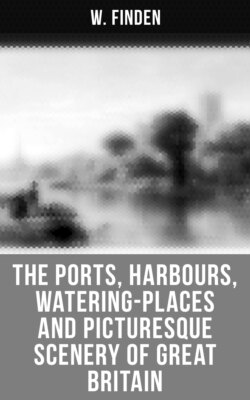Читать книгу The Ports, Harbours, Watering-places and Picturesque Scenery of Great Britain - W. Finden - Страница 17
На сайте Литреса книга снята с продажи.
WHITBY,
FROM THE NORTH-WEST.
ОглавлениеTable of Contents
The view of Whitby from the north-west, by Balmer, is taken from the sands near Upgang, between Whitby and the village of Sandsend. From this point nearly the whole of the west pier is seen, extending directly from the shore, and having a light-house near its outer extremity. Beyond the pier, and on the other side of the river, are seen the houses built on the sloping side of the cliff, and on its top the ruins of Whitby abbey, which
"In solemn grandeur, calm and still,
O'erlook the restless flood."
The first authentic notice that we have of Whitby, is contained in Bede's Ecclesiastical History. In the time of the venerable historian it was called in the Anglo-Saxon language Streoneshalh, a name which he interprets in Latin by the words Sinus Fari; that is, in English, "Light-house bay." Subsequently it received from the Danes its present name of Whitby, a word which is probably derived from hvit or whit, white; and by, a dwelling, or in its more extended sense, a village or town. It has been supposed that this name might be given to the village in consequence of its being built chiefly with stone taken from the ruins of the monastic buildings; but the supposition is untenable, unless we at the same time presume that the stones, which were taken from buildings which had been destroyed by fire, were rendered white by being burnt. In Domesday Book the place appears to be called Prestebi—Priestby—as well as Witeby—Whitby. The name Priestby, which soon became obsolete, probably denoted that part of the village which lay on the east side of the Esk, and was more immediately dependent on the monastery.
The abbey of Whitby, founded by St. Hilda in 658, acquired considerable importance as the residence of this saint, of whose miracles certain marvellous traditions are still current in this vicinity. At the dissolution, under Henry VIII., Richard Cholmley, Esq., obtained a lease for twenty-one years of the site of the abbey and several parcels of its lands. In 1550 those lands were sold by the crown to John, earl of Warwick, who again sold them to Sir John Yorke, of whom they were purchased by the original lessee, then Sir Richard Cholmley, in 1555. Since that time the property has continued in the family of Cholmley, who enjoy many valuable rights and privileges as lords of the manor of Whitby. On the dissolution of the monastery, the abbey was stripped of every thing that was valuable. The bells were taken down, and the church was unroofed for the sake of the timber and lead. The walls only were spared, as the cost of taking them down would probably have been greater than the value of the stones. Though time has destroyed much of Whitby Abbey, yet the ruins still form a conspicuous and interesting object when viewed from the sea. The tower, which for several preceding years had been in a tottering state, fell down 25th June, 1830. The parish church, a plain structure, probably founded about the beginning of the twelfth century, stands at a short distance to the north-westward of the abbey. The direct foot-way to the church-yard from the town is by a steep ascent of one hundred and ninety steps.
It is worthy of remark that the number of ships registered at Whitby by no means affords a criterion of the trade of the place, for the greatest part of them are freighted to and from other ports. Perhaps no port in the kingdom presents so great a difference as Whitby between the number of ships registered at the port, and the number annually entered and cleared. This discrepancy between the trade and the tonnage of the port arises from the circumstance of many wealthy persons who live there having their ships built and registered at Whitby, but chiefly employed, on freight, in the trade of other places. When speaking of the shipping of Whitby, it would be unpardonable not to mention that Captain James Cook one of the most distinguished of British circumnavigators, served an apprenticeship in a vessel belonging to that port.
The principal trades carried on at Whitby are ship-building, and the manufacture of sail-cloth. Its chief imports are coals from Newcastle and Sunderland, and timber, hemp, flax, tar, iron, and tallow, from the Baltic. Alum manufactured in the neighbourhood is shipped at Whitby, but the principal article of export is at present stones for building, of which great quantities are sent to London.
From the light-house, on the western pier, a tide-light is displayed at night time, as long as there is eight feet water on the bar. The light is stationary, and is visible at the distance of two leagues in clear weather. During the same period of tide, in the day, a flag is hoisted on the west cliff. It is high water at Whitby pier at forty minutes past three o'clock at the full and change of the moon.
ROBIN HOOD'S BAY.
